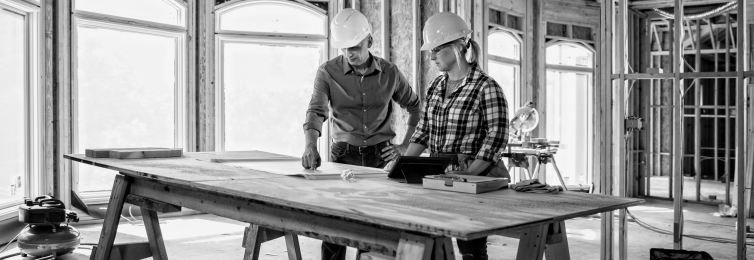Fire prevention and safety education is vital within every workplace. Regular drills, emergency training, and fire hazard awareness are accepted practices for offices, warehouses, and factories. The construction site, however, is a unique workplace setting with innately high fire risk—and potentially significant devastation. Michael Faith, Risk Management Consultant at Builders Mutual and a Certified Fire Protection Specialist, shares some industry-specific insights for fire prevention and safety.
The perfect storm for destruction
A fire on the job-site not only poses a threat to the lives of workers, but it also can devastate an entire project—from schedule disruption and site closure to total restart. When tradesmen are in the structure during construction, they are not protected by typical controls, such as smoke detectors and sprinkler systems, found in other places of business and homes. In fact, a framed structure without walls is basically a lumberyard set across the site. With so much wood and no separation to contain flames, a fire, which doubles in size every 30 seconds or less, will quickly consume all that readily available fuel.
Fire risks
The primary cause of construction site fire is hot work, such as welding, soldering, and grinding—anything creating a spark that could ignite nearby combustibles. These crews, specifically, need to be aware of the importance of working in environments that are clean and free of debris.
With the colder temperatures sweeping in, especially in more northern regions, temporary heaters can also put a job-site at risk for fire. In addition to providing comfort to workers, these heaters are often used to warm closed-off areas to set epoxy or other material. A tipped-over, too-close, overheated, or improperly fueled or powered heater can start an unnoticed fire.
But the item that all too frequently triggers catastrophic loss is only a couple of inches in length and often is flicked away without thought. A discarded cigarette butt hitting a pile of just-right material can create an unstoppable blaze in mere minutes. This instigator of devastation has caused some of the most costly losses in commercial construction.
Steps to stay safe
The following guidelines are essential to fire safety and prevention on the construction job-site. Some may be obvious to General Contractors (GC) and crew members alike, but this important topic warrants repeated warnings and education.
- Prohibit smoking on the job-site, or designate smoking areas far from debris and trash.
- Establish a Hot Work Safety Program for the job-site to reduce the unintended consequences from cutting, grinding, and other applications producing or using sparks, flame, or heat. This safety initiative would include: removing or protecting combustible material from the immediate area during the task; positioning a fire extinguisher close to the hot work location; and requiring crew members to remain in the immediate area for 30 minutes after hot work is complete.
- Have an emergency action plan. Designate responsibilities to key crew members for the various teams that go through the site. But make sure everyone takes responsibility to alert others to a fire, call 911, and ensure evacuation. Establish a post-evacuation meeting place so all employees can be accounted for.
- Fire extinguishers (per OSHA) should be available within 100 feet of any point within the work area—and all crew members need to know how to use an extinguisher correctly. (See sidebar for “PASS” instructions.)
- Be sure all fueling of portable equipment, such as generators, is done outside the structure, where gas spills are less likely to create imminent danger.
Be sure everyone on the job-site knows how to use a fire extinguisher. It’s easy to PASS the test!
-
Pull the pin.
-
Aim low at the base of the fire.
-
Squeeze the handle slowly.
-
Sweep the nozzle from side to side.
The best thing every GC and crew member can do to reduce fire risk is maintaining a clean and tidy job-site, keeping debris piles, dumpsters, and materials storage at least 20 feet away from the structure. Institute a clean-as-you-go policy or perform clean sweeps at lunch and at the end of each day to eliminate all trash piles throughout the site.
For additional construction site tips on fire prevention and safety education, check out this information from the National Safety Council. You can also contact your Builders Mutual Risk Management Consultant to learn more and make fire safety a priority on your job-site.




 Find an
Find an